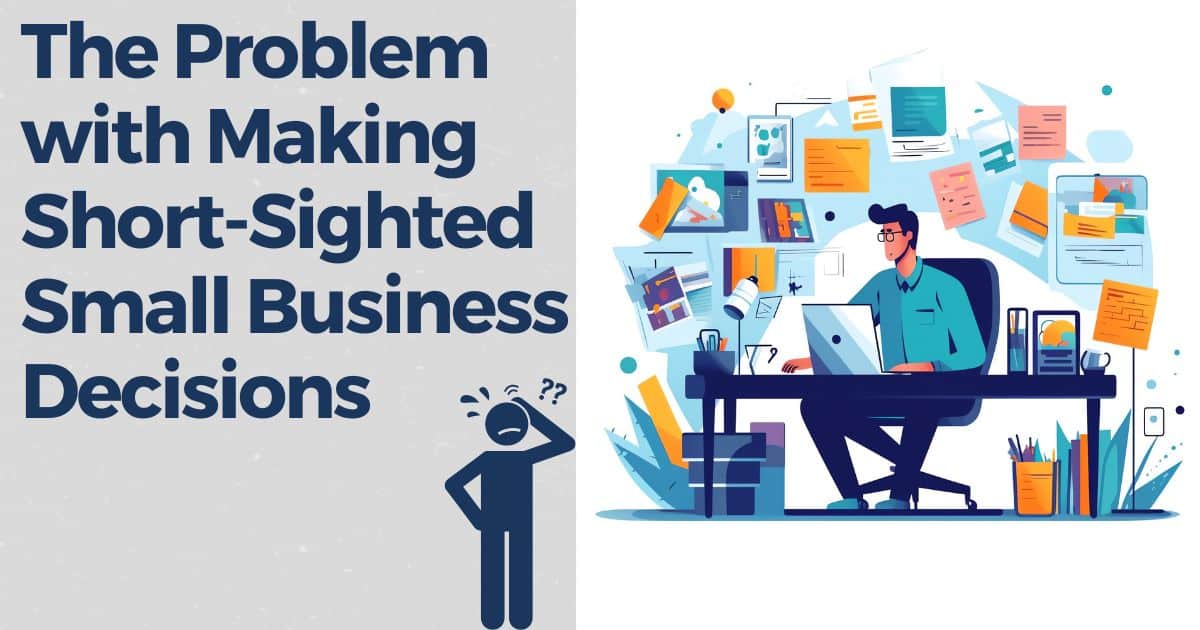The Problem with Making Short-Sighted Small Business Decisions
August 14th, 2023 | 3 min. read
By Anna Noa

Running a small business is hard. New problems and unforeseen circumstances can come up daily. Still, when you base your decision-making process on fixing everything in the “now,” you might actually be making your business’s “later” that much tougher. How do you balance the decision-making process between what’s right today and what’s right for your business five or ten years from now?
Unfortunately, there’s no easy answer. But as a company that’s worked to guide hundreds of small businesses in their decision-making processes, we have some insight into the pitfalls you REALLY want to avoid. Let’s talk about some of these common cycles that business owners can find themselves trapped in and how you can avoid making short-sighted business decisions.
Staffing decisions shouldn’t be based on “right now”
Your team is an extension of your business. Too often, we see folks making bad decisions on their staffing based on what’s going on RIGHT now. Say, you feel like your business needs more help, so you hire a bunch of folks out of desperation – only to realize a month or two later that you don’t have the recurring revenue needed to keep those employees on. That means more costly decisions on letting people go – and you’re not any closer to figuring out how many employees you *actually* need.
A similar hiring problem is the “good-bad” employee. You know who we’re talking about. Someone who doesn’t fit into the company culture but they’re an amazing salesperson and bring in a lot of revenue for your business. You know that they’re rude to customers and no one on the rest of the team likes them, but you’re in need of that revenue, so you keep them on. This is a common one we hear from folks and it usually ends with, “We should have fired them two years ago.”
As a small business, we’ve experienced these hiring pitfalls ourselves. In fact, if you want a fairly comprehensive list of our hiring mistakes, read about them here. But with these mistakes have come a lot of lessons learned.
[fl_builder_insert_layout id=9297]First, we say that we are “always hiring.” We believe that the right person is better than the right skillset almost any day. After all, skills can be taught. Values and personality - not so much. For this reason, we always have job listings open and encourage our staff to refer people to apply. This way, we don’t find ourselves in desperate need of a hire with no pipeline of people to start assessing.
Additionally, we’ve worked incredibly hard to objectify our hiring process. Essentially, this means that anyone on our team who interviews a possible candidate uses a value-based scorecard to assess the candidate. This practice is crucial to removing our personal bias from the hiring process and vetting individuals from the get-go for qualities we KNOW will be essential to fit in well with our team. If you’re interested in learning more about this process, we wrote a whole blog about it here.
Don’t get bogged down in the day-to-day
Oftentimes you know what the solution to your problems are: maybe you need to hire someone, you need to implement a new system or process, or you need to button down your client list. The problem is that you have 800 things on your plate that you have to get done – and if you don’t, no one will do them. So even if those things will fix your business long term, you can’t bring yourself around to making that happen.
That can be an attitude that iterates itself along with the growth of your business. If it’s early on and you only have a team of three or five people, it’s probably harder to think long-term because there’s so much to do RIGHT NOW. Putting off those bigger issues might seem OK as your business grows, but in reality, you’re multiplying the effect of those problems as your business grows.
As a first step, we advise at least considering the growth potential of some of your day-to-day decisions & investments. Need to implement a software that will help your team track stuff better? Evaluate how well each software scales and integrates with your current tech stack. Are details and communication regularly slipping through the cracks? Develop a process and take the time to train your team on how it works, even if that means pushing pause on the team’s productivity for a day. It will pave the way for more long term successes.
Sometimes you just need a little help
Often, the day to day just get to be too much to handle on your own. You have the self-awareness, but not the time. At Whirks, we strive to help businesses thrive by simplifying their people processes. In short, this means we can help you think through and automate some of those processes that have been bogging you down. We create systems that can free up your time so you can work more on your business, and less in your business. We’ll also help organize your reporting so that you can make decisions based on real numbers – not feelings.
If you’re interested in learning more about what it’s like to work with Whirks, check out the testimonial on this page.
The thing is: once you fix those bigger issues, some of the day-to-day ones vanish into thin air. You won’t have to bring in bad clients or bad fit employees just because you “need” them in the moment. You’ll be free to create a culture of growth based on the values you started with when you created your business. Ultimately, you’ll get the freedom you need to have the business you want – and THAT is long-term thinking.
Topics: